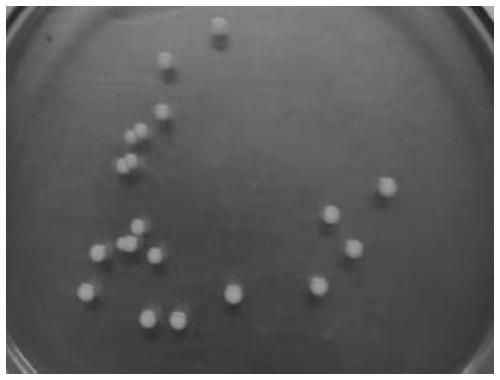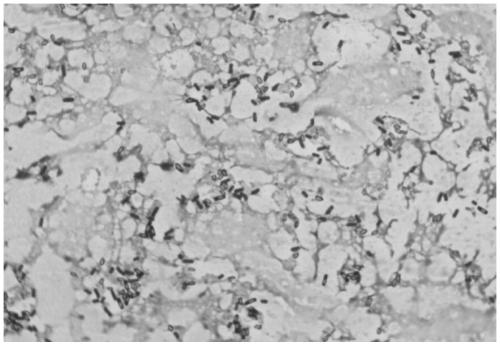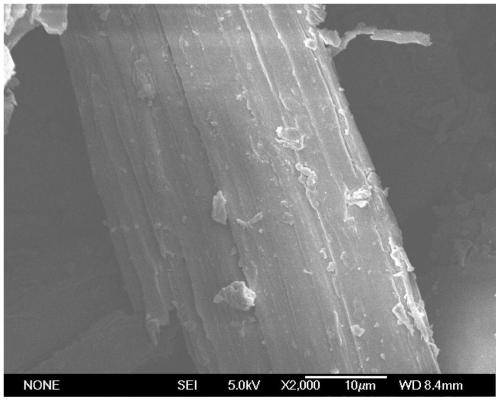Bacillus subtilis and culture method and application thereof
A Bacillus subtilis, culture method technology, applied in microorganism-based methods, biochemical equipment and methods, bacteria and other directions, can solve the problems of insufficient release of beneficial effects, poor degradation selectivity of strains, insufficient contact of strains, etc., to achieve excellent Straw adhesion, no laccase activity, mild treatment effect
- Summary
- Abstract
- Description
- Claims
- Application Information
AI Technical Summary
Problems solved by technology
Method used
Image
Examples
Embodiment 1
[0047] The screening process of Bacillus subtilis (Bacillus subtilis) ASD05 in the present invention is as follows:
[0048] (1) Primary screening
[0049] ①Collect fresh vermicompost from an earthworm farm in Shandong Province, put it into a sterile bag, store it in an ice bag and transport it back to the laboratory.
[0050] ② In order to eliminate the interference of unnecessary bacteria such as Escherichia coli and Enterococcus faecalis in vermicompost as much as possible, the samples were treated in a 70°C incubator for 2 hours and then taken out.
[0051] ③Crush the vermicompost samples under aseptic conditions, carry out gradient dilution with sterile distilled water, and select 10 -5 ~10 -8 Gradient dilutions were spread on the plates of screening medium 1, and cultured at 37°C for 24-48 hours until complete and clear colonies were formed;
[0052] Screening medium 1, the components are as follows:
[0053] Peptone 10g / L, yeast powder 5g / L, NaCl 10g / L, xylan 5g / L, ...
Embodiment 2
[0071] Identification of Bacillus subtilis ASD05 described in Example 1
[0072] (1) Strain morphology and physiological and biochemical identification:
[0073] Bacillus subtilis (Bacillus subtilis) ASD05 is cultured on a nutrient agar medium plate at 37°C for 24 hours to form white, round colonies with a diameter of 5-15mm and a thickness of 0.5-1mm. The surface of the colonies is rough and irregular. Wrinkled, with burrs on the edge; Gram staining is positive, and the shape of the bacterium under the microscope is short rod-shaped, with a size of 0.8-1.2μm×2-4μm, with endophytic spores, and the bacterium does not expand after the formation of spores, and the spores Located in the middle of the cell, the bacteria can move, see the colony and cell morphology of the strain figure 1 and figure 2 .
[0074] The main physiological and biochemical characteristics of Bacillus subtilis (Bacillus subtilis) ASD05, the test results are: contact enzyme experiment, glucose acid produ...
Embodiment 3
[0082] The cultivation method of Bacillus subtilis (Bacillus subtilis) ASD05 described in embodiment 1
[0083] (1) Take the activated Bacillus subtilis ASD05, inoculate it into a shaker flask equipped with a seed medium, and culture it on a shaker at 37° C. and 220 rpm for 24 hours to obtain liquid seeds;
[0084] The components of the seed culture medium are as follows: peptone 10g / L, yeast powder 5g / L, NaCl 10g / L, glucose 5g / L, and balance water;
[0085] The activated Bacillus subtilis (Bacillus subtilis) ASD05 is to inoculate Bacillus subtilis (Bacillus subtilis) ASD05 into the activation medium, and activate the culture at 37° C. for 24 hours; the activation medium is LB solid medium.
[0086] (2) Take the liquid seeds prepared in step (1), inoculate them in a shake flask equipped with an expansion medium at a ratio of 0.5% by volume, and culture them on a shaking table at 37° C. and 220 rpm for 36 hours to obtain the bacterial liquid;
[0087] The components of the exp...
PUM
| Property | Measurement | Unit |
|---|---|---|
| diameter | aaaaa | aaaaa |
| thickness | aaaaa | aaaaa |
| specific surface area | aaaaa | aaaaa |
Abstract
Description
Claims
Application Information
 Login to View More
Login to View More - R&D
- Intellectual Property
- Life Sciences
- Materials
- Tech Scout
- Unparalleled Data Quality
- Higher Quality Content
- 60% Fewer Hallucinations
Browse by: Latest US Patents, China's latest patents, Technical Efficacy Thesaurus, Application Domain, Technology Topic, Popular Technical Reports.
© 2025 PatSnap. All rights reserved.Legal|Privacy policy|Modern Slavery Act Transparency Statement|Sitemap|About US| Contact US: help@patsnap.com



